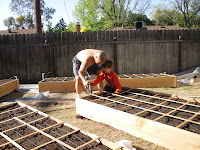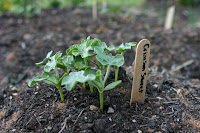
Every week at the Tuesday farmer's market, my first stop is to see Bob, from Coffee Pot Ranch, where we buy all our meat. I am
greeted every time with a huge smile and hug. We love Bob! My friendship with Bob started early on in my market shopping days when every week, along with the smile and hug, I'd get a "Good morning Julie!" Now, as many of you know, it is a bit awkward when someone gets your name wrong, especially someone you see regularly. I think I corrected him the first few times, but after that I just got used to it and it always gave me a giggle. When I started to see that he simply wasn't going to remember I wondered how he was going to feel when someone was with me and called me by name. If I come right out and tell him, he'll probably be embarrassed after all this time. I tried
writing a check a few times, so he'd see my name and he'd catch on for that day, but next week it was back to Julie again...did I mention that we love Bob!?
Finally one day I couldn't make it to the market and I sent Rick instead. I saw my opportunity! I told Rick to tell Bob that he was "Julie, whose real name is actually Sally's husband". Rick and Bob got a good laugh out of the whole thing and now, to Bob, I'm Sally Julie :o) It was the start of a beautiful friendship.
Becoming friends with the people who grow your food has its perks. We have made trips out to Bob and Shirley's farm, Coffee Pot Ranch in Sheridan a few times. Once I was having a dinner party and needed some Italian Sausage and I called him and headed on out. Again a huge warm welcome followed by a short farm tour and we were on our way, full stocked. One of the things you find when buying your meat farm direct is that you sort buy whatever they've got that week. I don't know about you, but in our house we LOVE bacon! It isn't available from Bob's farm each week because in order to send it to his processor he needs to have met a certain minimum weight. A few weeks ago Bob updated me with the upcoming bacon arrival and I planned my next visit to the farm the same day he arrived from the processor so that I could get first dibs. Rick, the kids and some friends (who also wanted to get their hands on some bacon) joined me for the trip. As always, Bob was gracious enough to give us a full tour, telling us the history of the farm, his family and the animals. We couldn't have planned it better, since that morning some baby pigs were born, which the kids all got a chance to hold. Good stuff....we love Bob!
Forever warm and inviting, Bob extended an invitation to us to join them for their annual "Ranch Party" which we just returned from tonight. Not knowing what to expect, we headed out to the farm with only about 1 1/2 before Rick had to head back for work. We regret that decision. This was a great party and none of us were ready to leave. Most of the people were other farmers, friends and family who all brought dishes to share, while Bob and Shirley served the most fantastic roast pig. Live music, dancing and good people sure made it hard to leave. I've already got the party on the calendar for next year...and I'll be sure we have more time to enjoy it.
The decision to attend tonight was sort of last minute, and being that it was a potluck I was forced to get creative in the kitchen. The salad I whipped up turned out pretty tasty, so seeing that I'm trying to be better about writing these successes down- here it is :o)
Green bean, tomato and roasted carrot salad with bacon vinaigrette
1 lb green beans, trimmed
1 lb cherry tomatoes, halved
4 carrots, peeled and cut to matchsticks
1 large leek, trim off green and thinly slice white
4 strips bacon, diced before cooking
salt and pepper
olive oil to drizzle on carrots for roasting
dressing:
1 shallot diced
1 t chives
2T red wine vinegar
3T olive oil
1 t Dijon mustard
1/4 t salt
1/4 t pepper
Preheat oven to 475. In large pot of salted boiling water, blanch green beans for about 2-3 minutes- remove from water to ice bath to stop cooking- set aside. Spread matchstick carrots on baking sheet, drizzle liberally with olive oil to coat, salt and pepper- roast for 15-20 minutes- watch carefully- should be fork tender when done- not mushy!! Meanwhile brown diced bacon, rendering out the fat in skillet over medium heat. Once crispy add leeks and saute until leeks are tender, about 5 minutes- can add extra olive oil if needed.
Dressing- in large bowl measure in all ingredients except olive oil- while whisking pour steady stream of olive oil to emulsify. Once all oil is added, add green beans, tomatoes, cooked carrots, leeks and bacon and stir. Serve room temperature.
 Every week at the Tuesday farmer's market, my first stop is to see Bob, from Coffee Pot Ranch, where we buy all our meat. I am greeted every time with a huge smile and hug. We love Bob! My friendship with Bob started early on in my market shopping days when every week, along with the smile and hug, I'd get a "Good morning Julie!" Now, as many of you know, it is a bit awkward when someone gets your name wrong, especially someone you see regularly. I think I corrected him the first few times, but after that I just got used to it and it always gave me a giggle. When I started to see that he simply wasn't going to remember I wondered how he was going to feel when someone was with me and called me by name. If I come right out and tell him, he'll probably be embarrassed after all this time. I tried writing a check a few times, so he'd see my name and he'd catch on for that day, but next week it was back to Julie again...did I mention that we love Bob!?
Every week at the Tuesday farmer's market, my first stop is to see Bob, from Coffee Pot Ranch, where we buy all our meat. I am greeted every time with a huge smile and hug. We love Bob! My friendship with Bob started early on in my market shopping days when every week, along with the smile and hug, I'd get a "Good morning Julie!" Now, as many of you know, it is a bit awkward when someone gets your name wrong, especially someone you see regularly. I think I corrected him the first few times, but after that I just got used to it and it always gave me a giggle. When I started to see that he simply wasn't going to remember I wondered how he was going to feel when someone was with me and called me by name. If I come right out and tell him, he'll probably be embarrassed after all this time. I tried writing a check a few times, so he'd see my name and he'd catch on for that day, but next week it was back to Julie again...did I mention that we love Bob!?








 The day starts out trying to catch the chickens. We threw a big plastic crate in the back of the truck and took it over to the tractor. As soon as we opened the top one jumped out. I started chasing it (very Rocky
The day starts out trying to catch the chickens. We threw a big plastic crate in the back of the truck and took it over to the tractor. As soon as we opened the top one jumped out. I started chasing it (very Rocky  But not this time. I was seasoned now. You might even say salty. We put about 30 birds in the truck and figured we'd come back for more later. No use making them too uncomfortable in the last few moments of their little chicken lives. I got the honors of getting in the tractor later in the day. Now honestly, if there is a part of processing day that is gross, it is crawling around in chicken poop on your hands and knees trying to grab those things. After a few minutes, I got the hang of it. I'd use a little board to corner them, reach into the mess of feather's and grab as many legs as I could get
But not this time. I was seasoned now. You might even say salty. We put about 30 birds in the truck and figured we'd come back for more later. No use making them too uncomfortable in the last few moments of their little chicken lives. I got the honors of getting in the tractor later in the day. Now honestly, if there is a part of processing day that is gross, it is crawling around in chicken poop on your hands and knees trying to grab those things. After a few minutes, I got the hang of it. I'd use a little board to corner them, reach into the mess of feather's and grab as many legs as I could get 






 Speaking of chickens, I got to help Brad and Alana Fowler at Fowler Farm with a day of chicken processing. Processing means killing if you couldn't figure it out. We "processed" about 67 chickens and I was able to try my hand at every step along the way. I'll write more about it another time but I'll just say it was pretty cool. I don't think I'd ever killed anything other than a fish or bugs before and I certainly hadn't done it with my hands. It wasn't ... it wasn't really anything. It wasn't sad or gross or good or bad. It was really like any job -- washing the dishes or painting the house. I am going to go back and help next week.
Speaking of chickens, I got to help Brad and Alana Fowler at Fowler Farm with a day of chicken processing. Processing means killing if you couldn't figure it out. We "processed" about 67 chickens and I was able to try my hand at every step along the way. I'll write more about it another time but I'll just say it was pretty cool. I don't think I'd ever killed anything other than a fish or bugs before and I certainly hadn't done it with my hands. It wasn't ... it wasn't really anything. It wasn't sad or gross or good or bad. It was really like any job -- washing the dishes or painting the house. I am going to go back and help next week.







































